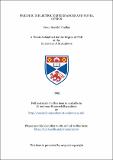Files in this item
Periodic dielectric disturbances and novel optics
Item metadata
| dc.contributor.advisor | Maitland, Arthur | |
| dc.contributor.author | Findlay, Ewan Donald | |
| dc.coverage.spatial | 186 p. | en_US |
| dc.date.accessioned | 2018-05-30T11:17:17Z | |
| dc.date.available | 2018-05-30T11:17:17Z | |
| dc.date.issued | 1995-07 | |
| dc.identifier.uri | https://hdl.handle.net/10023/13612 | |
| dc.description.abstract | Several possible methods for creating permanent and temporary periodic dielectric disturbances and their application to optics have been examined. The coupled mode theory is used to describe the travelling wave electro-optic diffractor (TWEOD) proposed by Dawber et al. A basic theoretical model of the TWEOD is presented and developed to give the design parameters for the construction of a working barium titanate TWEOD operating at 10 GHz. The coupled mode theory is also used to describe the dielectric disturbances created by pump beam interference patterns within a laser medium. Pump architectures which yield a periodic disturbance and thus create temporary diffraction gratings are analysed. Permanent dielectric disturbances can be generated in glass heated to temperatures above the transformation point. Some possible methods for imposing both uniform and periodic dielectric disturbances on glass, which are generated by imposing stresses on the glass whilst it is at its transformation temperature are proposed. Uniformly pre-stressed glass can be used to improve the angular response of glass acousto-optic diffractors. Periodically prestressed glass forms a permanent acousto-optic diffraction grating. Acoustic standing waves may also be used to induce periodic structural change in other transparent media and on the surface of etchable substrates. Such acoustically induced structures may be used as permanent diffraction gratings and holograms. A potential application for some of the novel devices described in this work is illustrated in the implementiation of an optical frequency division multiplexer ("optiplexer") for video signals (3 dB Bandwidth of 6 MHz) using acousto-optic frequency shifting techniques. This is a times six improvement on the channel bandwidth of 1 MHz for the optiplexer achieved by Dawber et al. | en_US |
| dc.language.iso | en | en_US |
| dc.publisher | University of St Andrews | |
| dc.subject.lcc | TK7871.22F5 | |
| dc.title | Periodic dielectric disturbances and novel optics | en_US |
| dc.type | Thesis | en_US |
| dc.contributor.sponsor | DRA | en_US |
| dc.type.qualificationlevel | Doctoral | en_US |
| dc.type.qualificationname | PhD Doctor of Philosophy | en_US |
| dc.publisher.institution | The University of St Andrews | en_US |
This item appears in the following Collection(s)
Items in the St Andrews Research Repository are protected by copyright, with all rights reserved, unless otherwise indicated.

